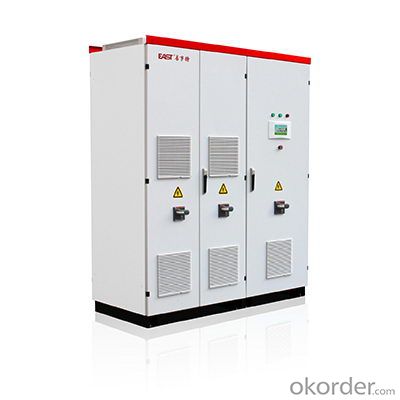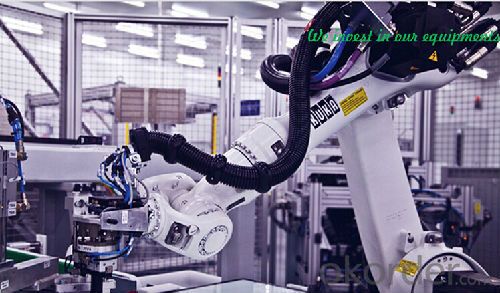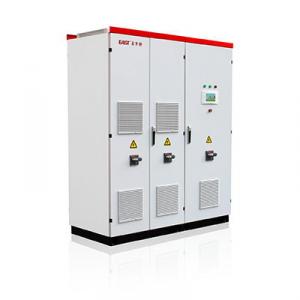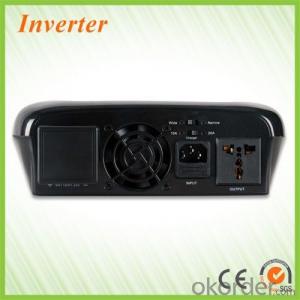EA500KTL/H Wider Input Voltage Range and Higher Efficiency ON-GRID PV - Central Inverter
- Loading Port:
- China main port
- Payment Terms:
- TT or LC
- Min Order Qty:
- 1 pc
- Supply Capability:
- 1000 pc/month
OKorder Service Pledge
OKorder Financial Service
You Might Also Like
EA500KTL/H
EA500KTF is designed with external isolation transformer. It has wider input voltage range and higher efficiency. Moreover, optical fiber isolation technology has been adopted to increase its anti-interference ability. Complete protection, higher MPPT efficiency, simple monitoring and capability of parallel operation make it ideal for large scale PV power plant.
● Maximum efficiency up to 98.7% (without transformer)
● Effective IGBT module
● Wide MPPT range, convenient for module configuration
● With DSP + CPLD digital control technology, having complete protection, safe and reliable
● Advanced MPPT (Maximum Power Point Tracking) algorithms
● Advanced Anti-islanding technology
● Efficient thermal system design, suitable for critical PV applications
● Multilingual LCD, easy to operate
● Integrated multi-communication interfaces, easy to monitor
● Low voltage ride through function
● For large centralized power plant connecting to high-voltage grid (with external step-up transformer)
● Active and reactive power regulation function (optional)
● TÜV CE, CQC certification
Specification / Type | EA500KTL | EA500KTH |
Input (DC) | ||
Max DC Voltage | 1000Vdc | |
Full-load MPPT Voltage Range | 450~820Vdc | |
Max DC Power | 550KWp | |
Max DC Current | 1200A | 1100A |
Number of DC Inputs | 16 | 16 |
Output (AC) | ||
Nominal AC Power | 500KW | |
Nominal AC Voltage | 270Vac | 350Vac |
AC Voltage Range | 210~310Vac | 245~362Vac |
Nominal Frequency | 50Hz/60Hz | |
Frequency Tolerance Range | 47-51.5Hz/57-61.5Hz | |
Distortion (THD%) | <3%(at nominal power) | |
Power Factor (Cos phi) | 0.9(leading)~0.9(lagging) | |
System Parameters | ||
Max Efficiency | 98.7% | |
Euro Efficiency | 98.5% | |
Protection Degree | IP20 (indoor) | |
Night Consumption | <100W | |
Operation Temperature Range | -25℃~+55℃ | |
Cooling | forced-air cooling | |
Relative Humidity | 0-95%, no condensation | |
Max Working Altitude | 2000m (derating above 3000m) | |
Display and Communication | ||
Display | LCD | |
Standard Communication | RS485 | |
Optional Communication | Ethernet /USB | |
Structure Parameters | ||
Dimensions(W×D×H) | 1800×800×2200mm | 1800×800×2200mm |
Weight | 1500kg | 1500kg |
· Q. What is an UPS and What it is for ?
An uninterruptible power supply (UPS) is a device that allows your computer or telephone switch or critical equipement to keep running for at least a short time or longer time when the primary power source is lost. It also provides protection from power surges, spikes, brownouts, interference and other unwanted problems on the supported equipment.
· Q. How long the UPS to run when power goes?
This can take 3 paths.
1.You can pick a UPS that is rated for pretty much the full VA you need so it will be running at 100% of capability and will thus last 'n' minutes.
2.You can pick a UPS that is rated at a much higher VA value than you really need so, for example, is running at 50% of capability and will thus last for longer than the UPS from option 1.
3.You can use extra external battery packs to run for longer. If charging capability allows, the more and the bigger batteries you take with, the longer time UPS runs.
or using a generator after about 6 hours, it will be more cost-effective, with a short runtime UPS to bridge the generator start-up gap.



- Q:How does a solar inverter handle variations in grid voltage?
- A solar inverter handles variations in grid voltage by constantly monitoring the voltage level of the grid. When there are fluctuations or variations in the grid voltage, the inverter adjusts its own output voltage accordingly to ensure a stable and consistent supply of electricity from the solar panels. This allows the inverter to efficiently convert the DC power generated by the solar panels into AC power that matches the grid voltage.
- Q:How does a solar inverter handle excess power production?
- A solar inverter handles excess power production by converting the surplus electricity generated by the solar panels into AC power, which can then be either used in the household or fed back into the grid for others to use.
- Q:What are the potential risks of electrical shock from a solar inverter?
- The potential risks of electrical shock from a solar inverter include: 1. Improper installation or faulty wiring, which may result in exposed live wires and increase the chances of electric shock. 2. Inadequate grounding or lack of proper safety measures, leading to the possibility of electrical leakage and shock hazards. 3. Accidental contact with energized components during maintenance or repair work, especially if proper safety precautions are not followed. 4. Inverter malfunctions or defects, such as insulation breakdown, which can expose individuals to electric shock. 5. Working with solar inverters in wet or damp conditions, as moisture can increase the conductivity of electricity and heighten the risk of shock. 6. Ignoring warning signs or not following manufacturer guidelines for safe operation and maintenance, which can contribute to electrical shock incidents.
- Q:What is the lifespan of a solar inverter?
- The lifespan of a solar inverter typically ranges from 10 to 15 years, depending on various factors such as the quality of the inverter, proper maintenance, and operating conditions.
- Q:How does a solar inverter affect the voltage stability of a solar system?
- A solar inverter plays a critical role in maintaining voltage stability in a solar system. It converts the direct current (DC) generated by solar panels into alternating current (AC) which is suitable for use in our homes and businesses. By regulating and adjusting the voltage levels, a solar inverter ensures that the power generated by the solar panels matches the required voltage of the electrical grid. This helps to maintain a steady and stable voltage output, preventing fluctuations and ensuring the smooth functioning of the solar system.
- Q:Is it possible to upgrade my existing solar inverter without replacing the entire system?
- Yes, it is possible to upgrade your existing solar inverter without replacing the entire system. In some cases, you may be able to replace the inverter with a more advanced model that offers improved efficiency or additional features. However, it is important to consult with a professional to ensure compatibility and proper installation.
- Q:What is the role of a solar inverter in protecting the electrical grid?
- The role of a solar inverter in protecting the electrical grid is to ensure the safe and efficient integration of solar power into the grid. It converts the direct current (DC) produced by solar panels into alternating current (AC) that is compatible with the grid. Additionally, solar inverters monitor and regulate the flow of electricity, providing grid stability by managing voltage and frequency fluctuations. They also incorporate safety mechanisms to disconnect from the grid in case of emergencies or grid disturbances, protecting both the solar system and the overall electrical grid.
- Q:Can a solar inverter be used in mobile or portable solar systems?
- Yes, a solar inverter can be used in mobile or portable solar systems. Portable solar systems often include a solar panel, battery, and inverter to convert the DC (direct current) power generated by the solar panel into AC (alternating current) power that can be used to power various devices and appliances. The inverter helps ensure compatibility and usability of the generated solar power in these mobile or portable setups.
- Q:What is the purpose of a solar inverter in a solar power system?
- The purpose of a solar inverter in a solar power system is to convert the direct current (DC) electricity generated by the solar panels into alternating current (AC) electricity that can be used to power household appliances or be fed back into the grid.
- Q:How does a solar inverter handle voltage sag and swell?
- A solar inverter handles voltage sag and swell by continuously monitoring the input voltage from the solar panels and adjusting its output voltage accordingly. In the case of voltage sag, when the input voltage drops below a certain threshold, the inverter boosts the voltage to maintain a stable output. Similarly, in the case of voltage swell, when the input voltage exceeds a certain limit, the inverter reduces the voltage to prevent any damage to the connected devices. This process ensures that the solar inverter consistently provides a steady and safe electrical supply.
1. Manufacturer Overview |
|
|---|---|
| Location | |
| Year Established | |
| Annual Output Value | |
| Main Markets | |
| Company Certifications | |
2. Manufacturer Certificates |
|
|---|---|
| a) Certification Name | |
| Range | |
| Reference | |
| Validity Period | |
3. Manufacturer Capability |
|
|---|---|
| a)Trade Capacity | |
| Nearest Port | |
| Export Percentage | |
| No.of Employees in Trade Department | |
| Language Spoken: | |
| b)Factory Information | |
| Factory Size: | |
| No. of Production Lines | |
| Contract Manufacturing | |
| Product Price Range | |
Send your message to us
EA500KTL/H Wider Input Voltage Range and Higher Efficiency ON-GRID PV - Central Inverter
- Loading Port:
- China main port
- Payment Terms:
- TT or LC
- Min Order Qty:
- 1 pc
- Supply Capability:
- 1000 pc/month
OKorder Service Pledge
OKorder Financial Service
Similar products
New products
Hot products
Hot Searches
Related keywords































